On the warpath: the development and modernisation of the Baltic states’ armed forces
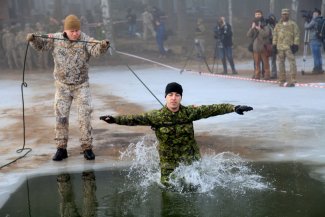
Russia’s full-scale invasion of Ukraine in February 2022 reinforced the sense of threat from Russia in the Baltic states, and spurred them to speed up the implementation of their national defence policies. Lithuania, Latvia and Estonia decided to boost their military spending and adapt their security objectives to the changing situation. The experience of the war in Ukraine and Russia’s crimes against the Ukrainian civilian population prompted the three countries to take steps aimed at ensuring that they could defend their entire national territories from day one of a possible attack. The new objectives of their security and defence policies are based on three pillars: achieving defence spending of at least 3% of GDP, securing the greater presence of allied forces, and fast-tracking technical modernisation combined with the development of their own armed forces and the expansion of their military infrastructure.
Wartime acceleration: strategy, spending, numbers
Russia’s invasion of Ukraine made it clear to decision-makers in the Baltic states that they needed to reformat their approach to national defence. Previously these countries mainly relied on allied deterrence, but after February 2022 they concluded that this had been insufficient. Now their goal is to strengthen both the presence of allied forces and their own capabilities. Their commitment to defending all of their territories from day one of a possible conflict exemplifies this new approach. The scenario in which parts of the country would be liberated after several weeks of fighting is no longer acceptable. At least on the verbal level, the leaders of Lithuania, Latvia and Estonia want to avoid a situation where Russian forces occupy a piece of their land and the conflict loses intensity. In order to achieve this new objective, they aim to increase the capabilities of their armed forces in an effective manner by modernising them and boosting their numbers. Another key factor in this context is the need to expand their military infrastructure in order to accommodate their growing armed forces and the allied troops deployed on their territories. The three countries have also pledged to build fortifications on their borders with Russia and Belarus to make their defences more effective. These plans can only be realised if they raise their defence spending rapidly, to at least 3% of their GDP.
The armed forces of Lithuania, Latvia and Estonia absorbed around 2% of their GDP in 2021, a level which they had maintained since at least 2019. In the spring of 2022, following Russia’s invasion of Ukraine, they decided to allocate more funds for this purpose (see charts below). In 2021-23 Lithuania reported the largest increase in defence spending, both in percentage (0.79%) and nominal terms (it almost doubled from €1.105 billion to €2 billion). In Estonia, the defence sector’s share of GDP rose by 0.87%, or €470 million (from €633 million to €1.103 billion). The slowest growth in defence spending was seen in Latvia, but even here the change between 2021 and 2023 was significant at €271m, or 0.28%.[1] All the Baltic states have set a target of raising their defence spending to 3% of their GDP in the coming years. Estonia will be the first to achieve this as its budget plans call for spending around 3.2% of its GDP on defence in 2024. Lithuania wants to cross the 3% threshold in 2025, although Latvia will not do so until 2027. They will mainly spend these funds on modernising their armed forces and building up their military infrastructure, followed by covering personnel costs.
Chart 1. The Baltic states’ nominal defence spending
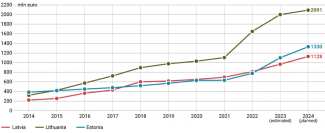
Source: NATO; plans for 2024 according to the Baltic states’ defence ministries.
Chart 2. The Baltic states’ defence spending relative to their GDP
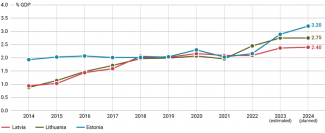
Source: NATO; plans for 2024 according to the Baltic states’ defence ministries.
Lithuania, Latvia and Estonia have also set the goal of increasing the size of their armed forces and their active reserves. Latvia decided in 2022 to reinstate conscription as one of the forms of compulsory national service;[2] under the current plans, it will carry out its first such draft this year. In 2023, the first group of 500 conscripts consisted of volunteers; from January 2024, the Latvian state will select around 600 candidates by lot. Estonia has maintained conscription without interruption since 1991. Every year, around 3500 Estonians perform eight- or eleven-month military service. In 2023, Estonia decided to increase the number of recruits to 4000 a year. Its national debate has featured proposals to extend military service to up to eighteen months, and to include women in defence duties. Lithuania reinstated conscription in 2015; around 3500 people receive military training annually. These issues have also been the subject of public debate in this country: there have been calls to increase the annual pool of those undergoing basic military training by shortening the length of basic service from nine to six months. Lithuania may not be able to implement its reform plans due to the upcoming parliamentary elections scheduled for the autumn of 2024.
The development and technical modernisation of the armed forces
Characteristically for small countries with limited demographic and economic potential, the regular armed forces of Lithuania, Latvia and Estonia are not very large. The national defence potential also includes relatively extensive territorial defence formations, which are often larger than the military active duty component; in Lithuania and Latvia, these are formally considered part of the armed forces (see Table 1 in the Appendix).
The land forces are the strongest branch of the Baltic states’ militaries. Lithuania has the largest of these: they comprise two active brigades (the mechanised Iron Wolf brigade and the motorised Žemaitija brigade), a reserve infantry brigade and six territorial defence battalions. Estonia has one mechanised brigade, a reserve infantry brigade and four territorial defence battalions. Latvia has the smallest regular land forces of the three countries, which include a single mechanised brigade supported by four territorial defence brigades. The Baltic states’ navies have similar capabilities and consist almost exclusively of used anti-mine and patrol vessels; Latvia is somewhat of an exception here in having new patrol vessels. The situation in their air forces is similar; they are equipped with just a few transport and training airplanes as well as multi-role and training helicopters. Lithuania stands out in this respect: so far, it is the only Baltic state to operate short-range air defence systems.
Just before the Kremlin launched its full-scale invasion of Ukraine, the Baltic states’ armed forces had launched long-term technical modernisation plans that were adopted following Russia’s annexation of Crimea in 2014. The further development and upgrades to these plans over the past two years have mainly focused on strengthening the land forces (see Table 2 in the Appendix). Lithuania and Estonia have decided to establish division-level commands to take operational control of their own and allied ground troops in the event that they have to conduct defensive operations. Latvia established such a command back in March 2019 in cooperation with Denmark. However, this does not mean setting up entire operational formations with all their typical subordinate support units (such as logistics, signal, artillery, air defence and engineering regiments) for peacetime. The Lithuanian division is expected to reach full combat readiness by 2030, and to act as a wartime structure that will be deployed only during mobilisation.[3] Lithuania has purchased a battery of the HIMARS rocket artillery system consisting of eight launchers which will most likely be directly subordinated to the division’s command. It will also upgrade its engineering and air defence battalions to regiment status.[4] Estonia has been working with the UK to establish a division-level command, which will eventually be integrated into the structure of NATO forces, but the date for its completion has not been published.[5] The battery of six HIMARS launchers that Estonia has acquired will instead form part of an artillery battalion. It will be directly subordinated to the division command, which has so far acted as an artillery training centre.[6] Due to budgetary and demographic constraints, as well as the small size of its armed forces, Latvia has not established a national division command. Instead, it has retained the existing structures of the Multinational Division North (MND N) based in Ādaži/Karup, which is jointly commanded by Latvia and Denmark.
Lithuania and Estonia face the common problem of equipping their army brigades to the required degree. In the Estonian mechanised brigade, only one of the three battalions is actually mechanised (it operates CV9035 infantry fighting vehicles), while the other two are only equipped with wheeled armoured personnel carriers armed with machine guns. Lithuania is in a better situation: by the end of 2023 it had managed to arm two of its Iron Wolf brigade’s four battalions with German-made Boxer wheeled armoured personnel carriers bearing the local name Vilkas. Thanks to their turrets with 30-mm automatic cannons and their Spike anti-tank guided missiles, they can be used as infantry fighting vehicles, while the other two battalions use the old M113 family of armoured personnel carriers. Both countries also lack modern self-propelled artillery: only one of their brigades is armed with it.
Lithuania still has not signed many of the arms contracts that have been announced over the past two years. As recently as April 2022 its government pledged to purchase additional Vilkas APCs from Germany, which would make it possible to arm two more battalions and create an equipment training reserve, but the contract has not yet been signed.[7] Lithuania has also announced its intention to purchase a battalion of Leopard 2 tanks (up to 54 vehicles) to equip one of the battalions of its Iron Wolf brigade.[8] On the other hand, it has managed to swiftly purchase an additional batch of US-made JLTV armoured vehicles, which will allow it to replace all the vehicles of this class in its armed forces. It has also signed contracts for a squadron of 18 French-made CAESAR howitzers for the Žemaitija brigade and for a third battery of the NASAMS system.[9]
Estonia has placed the greatest emphasis on the speed of deliveries and artillery. Indeed, the timeframe of deliveries was the reason why it purchased 130 Otokar Arma 6x6 wheeled armoured personnel carriers and 100 Nurol Yörük NMS armoured vehicles from Turkey in 2023; they are due to be delivered by the end of 2025.[10] These vehicles will allow it to fully equip the battalions of its two brigades within just two years. It has also expanded its order for Korean-made K9 howitzers, from 24 to 36. These are due to arrive in the country by 2026,[11] ensuring that both brigades will operate a battalion of modern, self-propelled artillery. Estonia also plans to acquire 12 French-made CAESAR howitzers for its division’s artillery battalion, in addition to the HIMARS launchers.[12] Besides strengthening its capability to conduct ground operations, Estonia has also enhanced its air defence by purchasing Polish-made Piorun man-portable anti-aircraft missile systems and, together with Latvia, an undisclosed number of batteries of the German-made IRIS-T SLM short-range air defence system.
Latvia has focused on air defence, an area in which it has invested heavily by purchasing Polish-made Piorun man-portable anti-aircraft missile systems and acquiring, together with Estonia, the aforementioned IRIS-T SLM batteries from Germany. In the years immediately preceding Russia’s full-scale invasion of Ukraine, Latvia had purchased used light combat vehicles, new armoured personnel carriers and helicopters; this meant that over the past two years it has not focused on investing in land forces as much as the other Baltic states. Thanks to financial support from the US covering 70% of the total cost, it has acquired a coastal defence battery equipped with Naval Strike Missiles.[13] A HIMARS battery of six launchers along with ATACMS short-range ballistic missiles has been the only recent significant purchase for its land forces. In October 2023, it also announced that it would acquire four MD530F light attack helicopters to perform training and battlefield support missions. However, the contract for these still has not been concluded.[14]
The presence of allied forces: the differences in scale and nature
Upgrading NATO’s multinational battlegroups from a reinforced battalion- to a brigade-level has become one of the most important goals for the Baltic states. However they have encountered considerable difficulties in achieving this goal, and have thus only partially succeeded. In 2023 only Lithuania and Latvia received the relevant pledges from Germany and Canada. In 2022, Estonia agreed to a compromise formula involving the assignment of a high readiness force from the UK which would remain on British soil, but could deploy to Estonia rapidly to form an entire brigade together with a permanent rotational presence in that country.[15] In return, the rank of the battlegroup’s commander was raised from colonel to brigadier general, and its command was expanded so that it could manage a brigade-sized force; in addition, regular exercises were launched to practice deploying the UK-based very high readiness forces to Estonia (albeit not all of them).
Lithuania has secured Germany’s pledge to deploy two battalions (a tank battalion and a mechanised battalion) and support sub-units on its territory on a permanent basis; these will form a joint brigade together with the NATO battlegroup that is permanently rotated there (currently numbering around 1400 troops, including some 850 from Germany). The German presence will be gradually expanded to reach full operational readiness by the end of 2027. Ultimately, the brigade will comprise around 5000 personnel, who will be stationed there permanently along with their families.[16] The Brigade Lithuania will be subordinated to the German 10th Armoured Division (Division 2025) rather than to the Lithuanian division. Thus, the aspect of integration and interoperability associated with the multinational battlegroup’s subordination to the Lithuanian brigade will be lost.
The future NATO brigade in Latvia will have a greater combat capability than the Latvian land forces. Latvia has secured Canada’s pledge to expand the NATO battlegroup: it has grown to become the largest contingent in the Baltic states, consisting of some 2000 troops, including around 1000 soldiers from Canada, 600 from Spain and 200 from Poland. By 2026, the number of Canadian soldiers is expected to rise to 2200, but their presence will remain rotational.[17] From 2025 they will be supported by Sweden and Denmark, which will alternately rotate a mechanised battalion as part of the NATO brigade.[18] The brigade itself will be part of the MND N, whose Ādaži/Karup command, as already mentioned, is shared by Latvia and Denmark. This force will operate more modern equipment than the sole Latvian brigade and be of a comparable size to it. The sole Danish brigade will most likely be the third brigade subordinated to MND N.
In addition to increasing the presence of NATO’s land forces, the Baltic states have started asking their allies to provide them with greater air defence capabilities. However, the number of aircraft deployed to supervise their airspace under NATO’s Baltic Air Policing mission has not increased. After temporary reinforcements in 2022, the allied forces have reverted to their standard rotation of around eight fighter jets from the Lithuanian base in Šiauliai and another four or so from Estonia’s Ämari; this rotation takes place every three months. In April 2024, Latvia’s Lielvārde was set to replace the Estonian base for about six months due to renovation work on the latter. The temporary deployment of medium-range (Germany’s Patriot system in Lithuania in the summer of 2023) and short-range systems (Spain’s NASAMS in Latvia since June 2022) has partly met the Baltic states’ need for greater air defence capabilities, but these are only stopgap measures. According to reports from Baltic military officials, NATO is planning to set up a mission involving the rotational presence of allied air defence batteries in the Baltic states. However, its details have not so far been disclosed.[19]
Estonia has been the biggest beneficiary of the significantly expanded US presence in the region. Before the war, US troops only occasionally appeared in this country as part of training exercises, but since December 2022 the US has had a permanent rotational presence of a HIMARS platoon supported by an infantry company. These forces have not only bolstered Estonian defences; they have also been training local soldiers to use the HIMARS launchers that Estonia has already purchased.[20] The size of the US contingent increased in 2023 when its infantry company was replaced by a infantry battalion detach from an infantry brigade combat team (IBCT) on rotation in Romania.[21] The US presence in Lithuania has only changed its nature, from temporary to permanent rotation. This means that the rotations of the armoured battalion (c. 600 soldiers) and the artillery battery detach from the Poland-based armoured brigade combat team (ABCT) are virtually continuous and sequential, ensuring that there are no periods without any US presence in Lithuania.[22] In Latvia the American presence is the least extensive, consisting of about five helicopters separated from the US Army’s rotating Combat Aviation Brigade (CAB) and the occasional participation of US sub-units in major exercises. There have been no changes to the size or shape of this presence.
The development of military infrastructure
The Baltic states need to upgrade their military facilities in order to increase the size of their armed forces and strengthen the presence of the allied forces on their territories. The goal that the defence ministries of Lithuania, Latvia and Estonia have set in this regard is to rapidly expand those training ground and garrison centres which can accommodate additional units. This is important in the context of plans to increase the number of active-duty soldiers and expand compulsory military service; at the same time, this is a fundamental condition for implementing the regional defence plans that were adopted at the 2023 NATO summit in Vilnius (see the Map in the Appendix).
The infrastructure used by the Baltic armed forces and their allies had slowly been reaching its limits even before the full-scale war in Ukraine broke out. For several years the Baltic states have faced the need to either upgrade sites such as Ādaži in Latvia, Tapa in Estonia and Rukla in Lithuania, or to create new ones. Expanding minor training grounds would solve these problems. In November 2023, the Estonian government decided to develop the Nursipalu area located in the southeastern Võru region. As part of these upgrades, it will be expanded by 3000 ha to almost 10,000 ha. The state is currently in the process of purchasing land from private owners and preparing the site for the project, but the final date for its completion is unclear at this point. Latvia will build the Selonia base on the border of the Jēkabpils and Aizkraukle regions southeast of Riga in order to meet the growing training needs of the allied forces in this country; it will cover an area of 25,000 hectares when it is completed in 2025. In Lithuania, the largest project of this kind is the post-Soviet Rūdininkai training ground in the Šalčininkai region, which is being expanded. According to the plans, it will cover an area of 17,000 hectares and should be completed by the end of 2026.
Work has also been ongoing at smaller military sites such as the Sirgala training ground in northeastern Estonia, which will triple in size from 2.79 hectares to 7.75 hectares. Lithuania has been carrying out work at the Gaižiūnai and Pabradė training grounds which US forces are using. It has also been expanding three new bases at Pajūris, Šiauliai and Rokantiškės, which will house a total of 2400 people.
It appears that the biggest challenge for the Baltic states in terms of military infrastructure is to invest in a line of fortifications on the borders with Russia and Belarus that could delay the military operations of these two countries in the event of an open conflict. Under the joint plan that Lithuania, Latvia and Estonia initiated when they signed a trilateral agreement in January 2024, a network of fortifications will be built along the entire length of their borders. Details of this concept have not been made public. It is also unclear whether all three countries will implement the project according to a common timeline and standards. In March 2024, Latvia became the first, and so far the only Baltic state to adopt a plan for this project. It assumes that much of the country’s defence infrastructure will be built over the next five years at a cost of €303 million. However, public statements by the Latvian defence minister and other officials suggest that a decade is a more realistic timeframe for completing work on this NATO border.[23]
APPENDIX
Map. Allied and national military infrastructure in the Baltic states
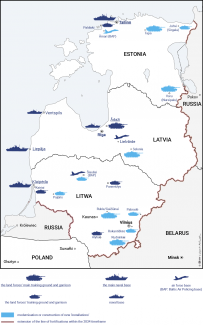
Table 1. The manpower of the Baltic states’ armed forces in 2021 and 2024[24]
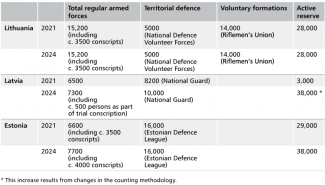
Source: NATO and the defence ministries of Lithuania, Latvia and Estonia.
Table 2. Technical modernisation of the Baltic states’ armed forces
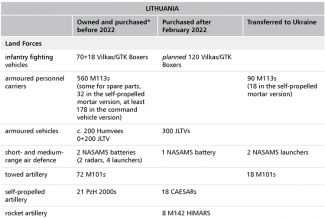
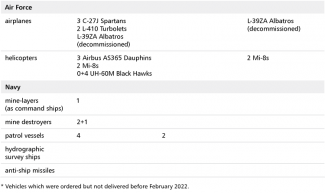
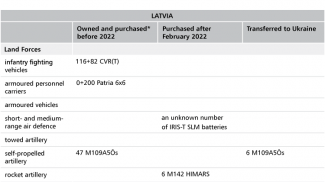

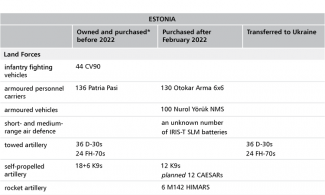

Source: the authors’ own compilation, based on data from the defence ministries of Lithuania, Latvia and Estonia.
[1] The figures aggregated by NATO differ slightly from those published by the defence ministries of Lithuania, Latvia and Estonia. The scale of these discrepancies is small from the macro perspective: it ranges from a few to more than ten million euros.
[2] B. Chmielewski, ‘Latvia to reintroduce conscription’, OSW, 14 September 2022, osw.waw.pl.
[3] ‘Establishment of a national division marks a historic step towards a new quality of the Lithuanian Armed Forces’, The Ministry of National Defence of Lithuania, 8 May 2023, kam.lt.
[4] ‘Infantry Division will be established, Leopard 2 tank platform acquisition approved’, The Ministry of National Defence of Lithuania, 23 January 2024, kam.lt.
[5] ‘Joint Statement by the Defence Ministers of the United Kingdom and Estonia’, Government of the United Kingdom, 12 July 2023, gov.uk.
[7] ‘Next stage in Vilkas Infantry Fighting Vehicle acquisition project in negotiations’, The Ministry of National Defence of Lithuania, 19 April 2022, kam.lt.
[9] I. Simensen, ‘Lithuania acquires more NASAMS air defence from KONGSBERG’, Kongsberg Defence & Aerospace, 14 December 2023, kongsberg.com.
[10] ‘Eesti ja Türgi kaitseministrid allkirjastavad kaitsetööstuste koostöökokkuleppe’, The Estonian Ministry of Defence, 18 October 2023, kaitseministeerium.ee.
[11] ‘Estonia buys 12 more K9 Thunders from South Korea’, Eesti Rahvusringhääling, 14 January 2023, news.err.ee.
[12] J. Piirsalu, ‘Eesti plaanib osta 12 ratastel liikursuurtükki ja ehitada uue sõjalaeva’, Postimees, 2 April 2024, postimees.ee.
[13] The contract's total value is $105 million. R. Plūme, ‘Latvia signs naval missile deal with the United States’, ENG.LSM.lv, 8 December 2023, eng.lsm.lv.
[14] R. Muczyński, ‘MD 530F dla Łotwy’, Milmag, 17 October 2023. milmag.pl.
[15] J. Tarociński, J. Gotkowska, ‘Expectations versus reality: NATO brigades in the Baltic states?’, OSW, 6 December 2022, osw.waw.pl.
[16] J. Gotkowska, J. Graca, ‘The German ‘Brigade Lithuania’’, OSW, 22 December 2023, osw.waw.pl.
[17] ‘Roadmap – Scaling the EFP Latvia Battle Group to Brigade’, Government of Canada, 11 July 2023, canada.ca.
[18] ‘Swedish soldiers to go to the Baltics’, The Swedish Armed Forces, 11 January 2024, forsvarsmakten.se.
[19] A. Stankevičius, ‘NATO ‘rolling out’ rotational air defence in Baltics – commander’, Lietuvos nacionalinis radijas ir televizija, 25 March 2024, lrt.lt.
[20] ‘Statement on U.S. Rotational Presence in Estonia’, The Estonian Ministry of Defence, 8 December 2022, kaitseministeerium.ee.
[21] ‘US military personnel based in Estonia now number around 600’, Eesti Rahvusringhääling, 9 September 2023, news.err.ee.
[22] ‘Enhancements to Persistent U.S. Force Presence in Lithuania’, U.S. Embassy in Lithuania, 7 December 2022, lt.usembassy.gov.
[23] ‘Eastern border counter-mobility plan approved by Latvia, EUR 303 million to be invested in strengthening of border’, The Ministry of Defence of Latvia, 3 June 2024, mod.gov.lv; ‘Sprūds: Baltic Defense Line construction could take a decade’, ENG.LSM.lv, 24 January 2024, eng.lsm.lv.
[24] The data available in NATO studies takes only the regular armed forces into account, and may differ from the figures provided by institutions from individual countries.





